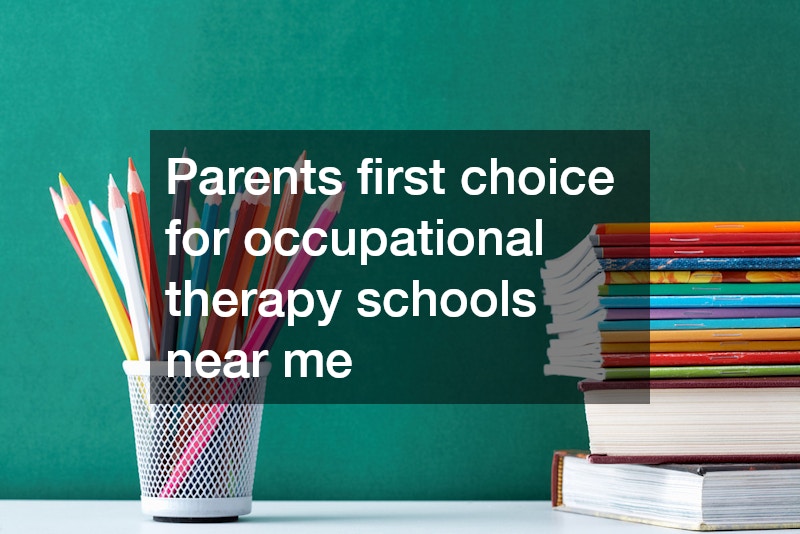
Parents first consider the long-term impact of their child’s education when selecting the right school, especially in specialized fields like occupational therapy (OT). This decision carries significant weight, as the quality of education and clinical training can deeply influence career success in the growing healthcare sector.
Rising Demand for Occupational Therapists
As the demand for healthcare professionals continues to rise, many parents are increasingly drawn to occupational therapy schools near me that offer robust and comprehensive programs. These schools provide both a strong academic foundation and hands-on clinical experience, which are essential for long-term career growth in the field. Some families also take into account proximity to other support services, such as a disability living service or access to a bed for kids with special needs, as part of their evaluation process.
What This Article Covers
In this article, we will explore the critical factors that influence parents’ decisions when choosing occupational therapy schools near me. From evaluating curriculum strength and faculty expertise to understanding financial aid options and future job prospects, parents must carefully assess multiple factors.
Helping Parents Make Informed Choices
By understanding what to look for, parents can make informed decisions that lead to the best educational path for their child. A well-chosen occupational therapy school can pave the way for a rewarding and stable career in the healthcare sector.
1. What Makes an Occupational Therapy School the First Choice for Parents?
Parents often have a checklist of factors when deciding which school is best for their child. For those looking into occupational therapy programs, it is essential to consider elements such as the reputation of the school, its affordability, and the quality of its curriculum. Here are the main factors that influence parents’ decisions:
Reputation of the School
Reputation plays a crucial role in any educational decision. Parents often prefer schools that are known for their strong academic performance and successful alumni outcomes. A reputable school typically has a solid track record of producing skilled graduates who are employed in relevant fields, ensuring that students are well-prepared for the workforce. The school’s ranking in OT-related fields is also significant, as it can impact the recognition and respect students will receive from future employers. Some parents even explore if the institution offers connections with programs such as an assisted living program, which aligns with many OT students’ long-term goals.
Affordability and Financial Aid Options
The cost of education is often a deciding factor for parents, and OT programs can be expensive. Fortunately, many schools offer financial aid packages that include grants, scholarships, and loan programs to ease the financial burden. Parents want to know that their investment in their child’s education is worth the cost. In some cases, families even consult a family lawyer to help navigate legal and financial planning, especially when considering long-term obligations like student loans or guardianship matters. The availability of financial aid, combined with the overall cost of tuition and living expenses, helps parents determine which schools offer the best value.
Curriculum and Accreditation
Parents look for schools with an accredited OT program that meets the standards set by professional organizations such as the Accreditation Council for Occupational Therapy Education (ACOTE). Accreditation ensures that the program provides the required knowledge and practical experience for students to become licensed occupational therapists. Parents must carefully review the curriculum to ensure that it aligns with their child’s career goals and interests.
Location and Accessibility
The location of the school plays a significant role, as many parents want their children to attend a nearby institution. Proximity to home can provide peace of mind and reduce the costs associated with relocation. Additionally, being close to family and familiar support systems can help students adjust to their new environment. Parents also look at the overall accessibility of the school, including transportation options and its proximity to healthcare institutions for potential internships or job placements. Some parents also consider nearby facilities such as memory care assisted living centers, where students might later gain valuable field experience.
2. How Do Parents Evaluate Occupational Therapy School Programs?

When evaluating occupational therapy programs, parents need to go beyond brochures and promotional materials. They must assess the program’s overall quality and its ability to prepare students for success in their careers. The following strategies are crucial for evaluating OT programs:
Reviewing School Rankings
School rankings can provide valuable insight into the quality of education and the strength of the program. Parents often look for schools that rank highly within the field of occupational therapy, as these schools typically offer better facilities, more experienced faculty, and greater networking opportunities. Rankings can also reflect the program’s overall success in producing graduates who go on to secure good jobs in the field.
Understanding Program Requirements
Parents should thoroughly understand the program’s admission requirements and curriculum structure. OT programs often require a strong background in science and healthcare-related subjects, so it’s essential to understand the prerequisites for acceptance. Understanding the level of coursework and the expectations of students will allow parents to make a better assessment of whether the program is a good fit for their child’s capabilities and career goals.
Feedback from Alumni and Current Students
Feedback from alumni and current students is invaluable when evaluating a school’s program. Parents should seek out reviews and testimonials from individuals who have completed or are currently enrolled in the program. This feedback can give parents an idea of the school’s strengths and weaknesses, as well as the support provided to students during their studies. For greater transparency, some families even request information through paper shredding services to ensure secure document handling during application and review.
Visiting the Campus
Visiting the campus in person is one of the best ways to get a feel for the environment. Parents can tour the facilities, meet faculty members, and interact with current students to get a sense of the school’s culture. Seeing the campus firsthand allows parents to assess the overall atmosphere and determine if it aligns with their values and expectations.
Comparing Syllabi and Coursework
It’s important for parents to review the syllabi for the courses included in the OT program. By comparing the coursework offered at various schools, parents can determine which programs provide the most comprehensive and up-to-date education. A strong curriculum that includes both theoretical learning and hands-on practical experience will better prepare students for the demands of the workforce.
3. How Important is the Faculty in Parents’ First Choice Decisions?
The quality of faculty members is a critical factor in the decision-making process. Faculty expertise and teaching approach significantly impact the education students receive. Here are key factors related to faculty that parents consider:
Professor Qualifications and Expertise
Parents want to ensure that the faculty members teaching in the OT program are highly qualified professionals with relevant experience. Professors who are experts in their field, have worked in clinical settings, and have a background in research will provide students with valuable insights and guidance. A faculty with a combination of practical experience and academic knowledge can make the learning experience more enriching and realistic.
Student-to-Faculty Ratio
A low student-to-faculty ratio is often considered an indicator of a high-quality educational experience. When there are fewer students per professor, students tend to receive more personalized attention and have greater access to faculty for mentoring and guidance. This one-on-one interaction is especially important in an OT program, where students benefit from hands-on instruction and individual feedback.
Availability of Mentoring Programs
Mentoring is vital in occupational therapy education, and parents want to know that the school offers strong mentoring programs. Whether through faculty mentorship or peer-to-peer guidance, these programs help students navigate their academic journey, gain career insights, and develop professional networks. Some schools even bring in professionals such as an employment mediator to offer conflict resolution training and real-world insights into workplace dynamics, further enriching students’ preparation. Parents are more likely to choose schools that provide formal or informal mentorship opportunities that include exposure to real-world professional development.
Faculty Research and Publications
Professors who are involved in research or have published work in relevant OT fields can offer students a deeper understanding of the subject matter. These faculty members may bring innovative teaching methods and the latest industry trends to the classroom, enhancing the overall quality of the education provided.
Teaching Philosophy and Approach
A school’s teaching philosophy can greatly affect students’ educational experience. Parents should consider whether the school emphasizes practical learning, student engagement, and collaborative projects. Schools that foster critical thinking, problem-solving, and independent learning will better prepare students for the challenges they will face in their OT careers.
4. What Role Does Peer Interaction Play in Parents’ Decisions?

Peer interaction is a critical aspect of the overall student experience. For parents, it’s important to know that their children will be in an environment that encourages collaboration, diversity, and personal growth. The following factors play a significant role:
Student Diversity and Inclusion
A diverse student body promotes cultural exchange and prepares students for the real-world work environment, where they will interact with people from various backgrounds. Parents often prefer schools that prioritize diversity and inclusiveness, ensuring their child will have the opportunity to interact with a variety of perspectives and experiences.
Networking Opportunities
Networking is an essential aspect of career development, and OT students benefit from building strong professional connections during their studies. Parents should look for programs that offer networking opportunities through conferences, student organizations, and alumni groups. These networks can help students secure internships, find mentors, and land jobs after graduation.
Student Organizations and Clubs
Active student organizations and clubs provide opportunities for students to connect with peers who share similar interests. Many OT programs have clubs dedicated to professional development, community service, and social activities. Parents appreciate schools that support such extracurricular engagement, as these activities help students build leadership skills and form lasting friendships. In some cases, students may even participate in a tennis program or similar activity as part of a well-rounded college experience.
Socio-Cultural Environment
The socio-cultural environment of a school can have a significant impact on a student’s overall well-being. Parents are keen to find institutions that foster a positive, supportive, and inclusive atmosphere, where their children will feel safe, respected, and encouraged to thrive. Many schools now emphasize mental health resources and support services that mirror those found in memory care assisted living communities—structured, compassionate, and personalized environments focused on wellness. In cases where children have specific needs, such as those requiring a bed for kids with special needs, the availability of tailored accommodations can be an important consideration. An environment that values mental health and wellness is crucial for ensuring students’ success both academically and personally.
Peer Support Systems
Peer support systems are often built into occupational therapy programs to help students succeed. These can include study groups, peer mentorship, and emotional support networks. For many parents, the presence of such support systems is an important consideration, as they can make a big difference in a student’s ability to navigate the challenges of a rigorous academic program.
5. How Do Extracurricular Activities Matter in Choosing OT Schools?

While academics are crucial, extracurricular activities also play an essential role in the development of well-rounded students. Parents often look for schools that offer diverse extracurricular opportunities to support their children’s personal and professional growth.
Availability of Sports and Fitness Programs
Physical well-being is a key component of occupational therapy, and parents appreciate schools that offer sports and fitness programs. Engaging in physical activities can help students maintain a healthy balance between academic stress and personal well-being. Additionally, participating in fitness programs can allow students to develop the kind of skills they might later incorporate into their own practice as occupational therapists.
Participation in Community Service
OT professionals are often involved in community-based work, whether it’s helping those with disabilities or providing rehabilitation services. Many parents appreciate schools that offer opportunities for students to participate in community service projects or volunteer work, as this helps students develop empathy and a deeper understanding of the needs of diverse populations. Some of these opportunities may even include partnerships with a disability living service, adding hands-on experience that directly benefits future practice.
Development of Soft Skills
In addition to academic knowledge, soft skills like communication, teamwork, and leadership are essential for OT professionals. Schools that provide opportunities to develop these skills through extracurricular activities are often highly valued by parents. Whether through involvement in student organizations, group projects, or leadership roles, extracurriculars can help students build the interpersonal skills they will need in their future careers.
Opportunity for Creative Pursuits
Creativity is an essential aspect of occupational therapy, as it involves finding innovative solutions to help people perform daily tasks. Parents often prefer schools that encourage creative pursuits, such as art clubs, theater programs, or design workshops, which allow students to explore their creative side and apply these skills in therapeutic settings.
Balance Between Academics and Extracurriculars

Choosing the right occupational therapy school is a complex process that requires parents to carefully weigh multiple factors. From evaluating the curriculum, faculty, and financial considerations to examining the school culture and career opportunities, there are many elements to consider. In some cases, families may even consult a family lawyer to help navigate legal or custodial concerns related to school choice or financial aid.




